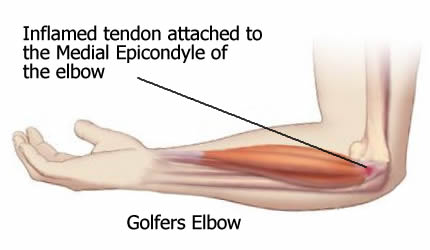Tennis Elbow (Lateral epicondylitis)

Tennis elbow, as the name implies, often is caused by the force of the tennis racket hitting balls in the backhand position. The forearm muscles, which attach to the outside of the elbow, may become sore from excessive strain.
When making a backhand stroke in tennis, the tendons that roll over the end of the elbow can become damaged. Tennis elbow may be caused by the following:
The following are the most common symptoms of tennis elbow. However, each individual may experience symptoms differently.
Initially, the pain may be felt along the outside of the forearm and elbow. The pain may increase down to the wrist, even at rest, if the person continues the activity that causes the condition. Pain may also persist when the arm and hand are placed palm-down on a table and the person tries to raise the hand against resistance, or with lifting and gripping small objects, such as a coffee cup.
The symptoms of tennis elbow may resemble other medical problems or conditions. Always consult your doctor for a diagnosis.
How is Tennis Elbow Diagnosed?
The diagnosis of tennis elbow usually can be made based on a physical examination. However, in some cases, an X-ray, magnetic resonance imaging (MRI), and electromyography (EMG) of the elbow are necessary.
Treatment for Tennis Elbow
Specific treatment for tennis elbow will be determined by your doctor based on:
Medial Epicondylitis (Golfer’s Elbow)

Medial epicondylitis, also known as golfer's elbow, baseball elbow, suitcase elbow, or forehand tennis elbow, is characterized by pain from the elbow to the wrist on the inside (medial side) of the elbow. The pain is caused by damage to the tendons that bend the wrist toward the palm. A tendon is a tough cord of tissue that connects muscles to bones.
What Causes Medial Epicondylitis?
Medial epicondylitis is caused by the excessive force used to bend the wrist toward the palm, such as swinging a golf club or pitching a baseball. Other possible causes of medial epicondylitis include the following:
What are the Symptoms of Medial Epicondylitis?
The following are the most common symptoms of medial epicondylitis. However, each individual may experience symptoms differently.The most common symptom of medial epicondylitis is pain along the palm side of the forearm, from the elbow to the wrist, on the same side as the little finger. The pain can be felt when bending the wrist toward the palm against resistance, or when squeezing a rubber ball.
The symptoms of medial epicondylitis may resemble other medical problems or conditions. Always consult your doctor for a diagnosis.
How is Medial Epicondylitis Diagnosed?
The diagnosis of medial epicondylitis usually can be made based on a physical examination. The doctor may rest the arm on a table, palm side up, and ask the patient to raise the hand by bending the wrist against resistance. If a person has medial epicondylitis, pain usually is felt in the inner aspect of the elbow.

 Call us: +91884-2388888, 6668888
Call us: +91884-2388888, 6668888



